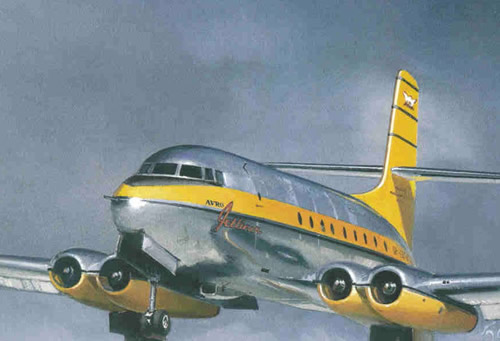|
Canada’s Only Jetliner: The C-102Canada’s
Only Jetliner: The C-102
September 26th, 2007
By:
Raul Colon
E-mail: rcolonfrias@yahoo.com
PO Box 29754
Rio Piedras, Puerto Rico 00929

Tested for the first time
during the morning of August 10th, 1949; just a few weeks after de
Havilland’s successful test of its Comet Jetliner; the C-102 was the first
and last major attempt by a Canadian company, in this case the AV Roe
Canada Limited, to built a commercial jetliner. Although some airlines,
especially in the United States, showed some interest, the advent of the
Korean War and the urgent need to provide the Canadian Royal Air Force
with CF-100 fighters, terminated the program in 1951. The C-102 was a
futuristic aircraft design, one very similar to the Comet. The C-102
original program called for the construction of two prototype planes.
These aircraft were designed to gather information about the handling
characteristics of the 102 and its engine performance at high speed. In
the end, only one operational 102 was ever manufactured. The other example
was almost complete when the program was terminated.
The only 102 produced had a fuselage of 80’-9” in length with a height of
26’-5”. The wing span was 98’-0” with total wing area being 1,156sq ft.
Full pressurization was one of the main features of the 102. With the
advantage of pressurization, the 102 could accommodate thirty to fifty
passengers plus a crew of three. The main cabin was fitted with noise
reduction materials and equipment in order to reduce the noise signature
of the four Rolls-Royce Derwent 5/17 (3,600lb) turbojets mounted on the
wing structure near the main fuselage. There were talks between Avro and
the Canadian government to change the engine configuration in favor of the
newest Rolls-Royce’s AJ-65 turbojet engine, but the British government did
not permit Rolls-Royce to realize the engine system for use in a civilian
aircraft. Its tail was, like many of its contemporaries, upswept. The
102’s flight deck was conventional in layout fitted with dual control
systems for the pilot and co-pilot. The plane undercarriage consisted of a
tricycle configuration with its main dual wheels retracting into the rear
of the engine area, while the front wheel would do the same under the
plane’s nose cone. The Rolls-Royce engines installed on the 102 gave the
aircraft top speed of 430mph. It also provided the C-102 with the ability
to climb at an impressive 1,840ft per minute. Operational service ceiling
was a pleasant 37,300’. With all fuel tanks filled, the C-102 was able to
operate at a range of 1,250 miles.
After a gruelling series of taxi testing, the 102 became airborne for the
first time in August 10th. With its maiden test, the 102 defeated Boeing’s
efforts to be the first company to fly a commercial jetliner over the
skies of North American, by almost three full years. The 102 had another
claim to fame. After the cancellation, the lone operational C-102 sample
was sent to the U.S. for further testing before the prototype was sent
back to Avro for data collection on the CF-100 program. The other
prototype was destroyed within a year after termination. Today only the
nose cone of the 102 survives. It is on display in Canada’s National
Aeronautical Collection Center. A lone remainder of an era long past.

|
